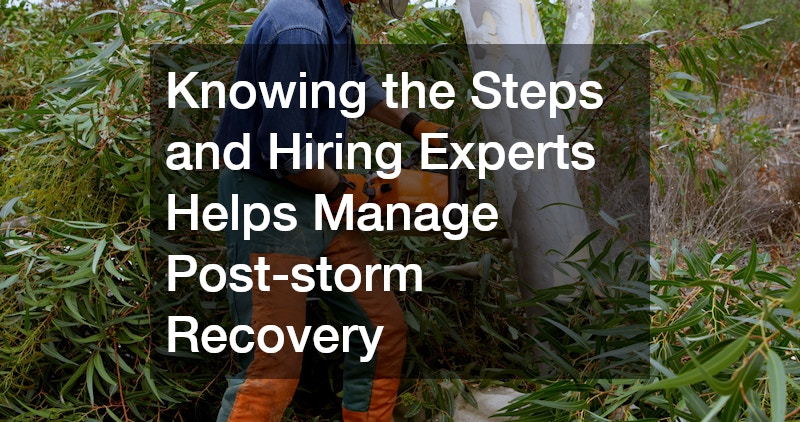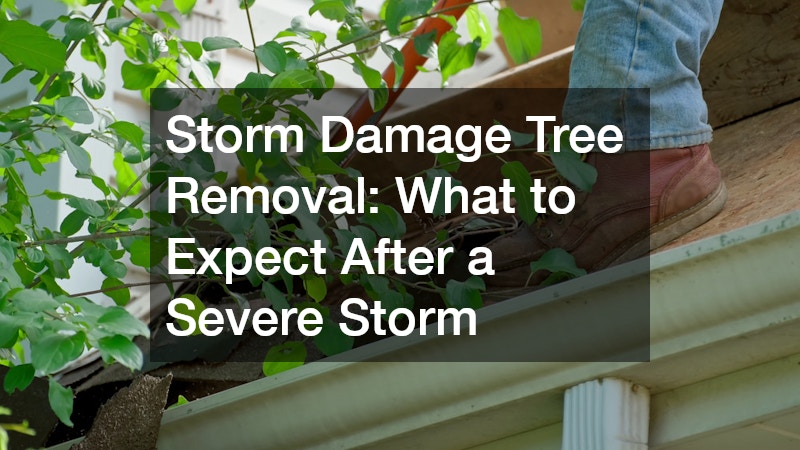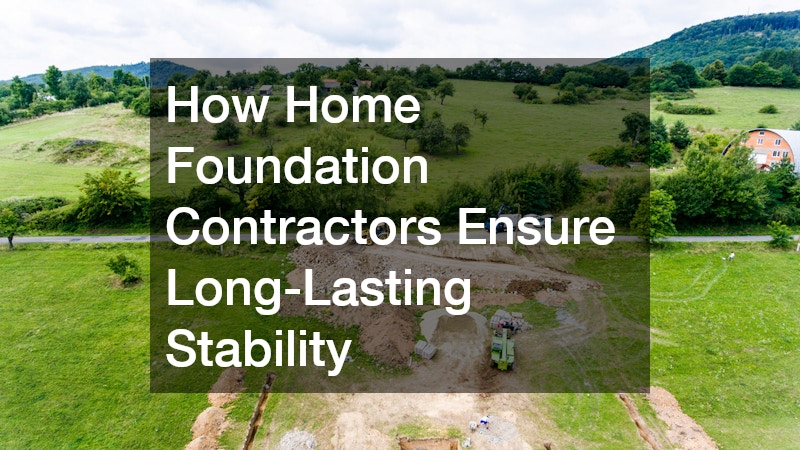Severe storms can unleash significant destruction, leaving trees damaged and landscapes altered in their wake. Understanding the process of addressing tree damage after such events is crucial for property owners looking to restore safety and aesthetics to their surroundings.
What are the First Steps in Addressing Storm-Damaged Trees?
Assessing the Damage
After a severe storm, carefully inspecting and assessing the extent of damage to trees should be the first priority. This involves looking for visible signs of structural weakness, broken limbs, and uprooted roots, which can be indicators of serious damage.
Taking note of any leaning trees and cracked trunks is essential for understanding stability issues. A comprehensive assessment helps in deciding the next steps, including whether a tree can be treated, preserved, or needs immediate removal.
Remember that injuries such as deep splits or exposure of roots require prompt attention. Ignoring these issues can lead to further risk, making professional assessment advisable when the damage is beyond basic observation.
Prioritizing Safety
Safety should always be the top consideration when dealing with storm-damaged trees. Downed power lines and unstable trees pose significant hazards that must be dealt with immediately.
Creating a safe perimeter around the affected area ensures the protection of both people and property. It’s critical to use caution and protective gear if you need to approach any damaged trees.
Before undertaking any removal or repair work, evaluate the site for potential dangers like hanging branches or weakened limbs. Contacting utility companies for downed power lines is a necessary safety protocol.
When Should You Call a Professional Tree Removal Service?
Recognizing Complex Situations
There are scenarios where calling a professional tree removal service is not just advisable, but necessary. If a tree has fallen onto a structure or is entangled with power lines, professional expertise is crucial to manage the potential danger effectively.
Complex situations, such as trees with multiple limbs severely damaged or precariously hanging, require experienced professionals to prevent further property damage or personal injury. Professional arborists are equipped with the tools and knowledge to handle these intricacies.
Statistically, improper handling of tree removal can lead to accidents and increased repair costs. Hence, recognizing when professional intervention is required can save time, money, and possibly lives.
Understanding Cost Factors
Several factors influence the cost of professional tree removal services, from the tree’s size to the complexity of the removal job. The location of the tree, access for equipment, and disposal of debris can also impact the overall price.
Discussing anticipated costs upfront with a professional service helps to avoid surprise charges later. They can provide a detailed breakdown of necessary procedures and associated costs.
Additionally, some homeowners’ insurance policies may cover part of the tree removal expenses if it’s a result of a storm, so it’s worth querying your insurer. Understanding these factors can help homeowners better prepare financially for potential expenses.
How to Choose the Right Tree Removal Service?
Checking Credentials and Experience
When choosing a storm damage tree removal service, it’s important to verify the company’s credentials and experience. Ensuring they have the necessary licenses and insurance protects you from liability and ensures a higher standard of service.
Experience in handling storm-damaged trees indicates proficiency. Companies with a longer track record are often well-versed in both safety and efficiency.
By choosing certified arborists, you increase the likelihood of successful outcomes. Their specialized knowledge in tree health and removal can make a significant difference in the overall process.
Reading Reviews and Getting Quotes
Reading reviews from past clients can provide valuable insight into the reliability and quality of a tree removal service. Positive feedback is a good indicator of customer satisfaction and service efficiency.
Obtaining multiple quotes can also aid in choosing the right service provider. Comparing costs and services offered ensures you get the best value without compromising on quality.
Engaging three to four reputable companies and discussing your specific needs helps in gaining a better understanding of what to expect. Personal recommendations from friends or neighbors can be equally useful.
Can Damaged Trees Be Saved Rather Than Removed?
Identifying Salvageable Trees
Not all storm-damaged trees require removal; some may be salvageable. Knowing the criteria for saving a tree, such as damage to less than 50% of the tree’s crown or relatively minor trunk damage, is key to decision-making.
An arborist can help determine the viable options for saving a tree suspected to be salvageable, leveraging their expertise to evaluate structural integrity and recovery potential. Keeping a damaged tree could contribute greatly to landscape aesthetics and environmental benefits.
However, trees with extensive root damage or those that pose a high risk of failure should be removed. Consulting with professionals ensures the right judgment on whether a tree can safely remain standing.
Treatment and Care for Damaged Trees
For trees deemed salvable, a proper treatment and care plan is essential for recovery. Pruning damaged branches and providing adequate water and nutrients are the initial steps in the care process.
Regular monitoring for signs of stress or disease post-treatment is vital. An expert might recommend support systems or further trimming as part of the tree’s rehabilitation plan.
Rehabilitation may also include soil treatment to promote root health and structural stability improvements. These accumulated efforts can greatly enhance a tree’s chances of a full recovery.
Addressing storm-damaged trees requires a blend of safety, expertise, and timely action. Proper assessment and the decision to remove or save affected trees play a crucial role in maintaining landscape health and safety.
By understanding the necessary steps and engaging qualified professionals when needed, property owners can navigate post-storm scenarios more effectively. Preparedness and preventative care for future storms ensure not only aesthetic conservation but also property and personal safety.





